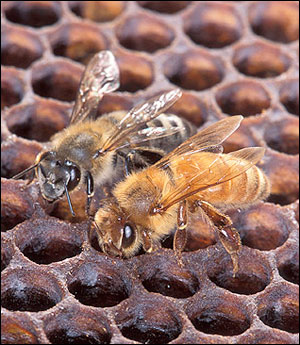More on Nesting Bees

Adult African honeybees, ©UF/IFAS
By Dr. Jamie Ellis
The reason the Florida Department of Agriculture and Consumer Services (FDACS) recommends removing or eradicating feral honey bee colonies or swarms, especially those located in close proximity to places people or animals frequent, is because of the presence of Africanized honey bees in Florida.
Africanized honey bees (AHBs) and European honey bees (EHBs) (the kind beekeepers keep) cannot be distinguished from one another with the unaided eye. One of the few ways to determine the likelihood that a given bee is African or not is by performing a morphological, computer-assisted test. Obviously, it is not safe to tell a resident to collect a sample of bees from a living bee colony. Thus, the state recommends that a sample be taken from the remains of an eradicated colony, and then only if the homeowner, property owner, or property manager is interested in knowing the identity of the bees.
For more information on how to get bees tested for Africanization please contact the FDACS Apiary Inspection Section.
Additionally, EHBs and AHBs are capable of interbreeding, meaning a hive that has been in a structure quietly for years may become Africanized suddenly if it rears a new queen who subsequently mates with drones (male bees) from African colonies.
Besides general safety, nesting honey bees and swarms become a liability issue for the homeowner. If the suspect bees are Africanized and attack a neighbor's child, pet, etc., the homeowner may be liable for the attack because they were aware of the colony's presence and did not initiate its removal or eradication. Many bee attacks are reported to occur on victims who knew the colony was there but did nothing about it since "the bees seemed calm."
It only takes a few seconds for AHBs to become defensive if disturbed, and the bees will travel much further from the nest than will EHBs, thus creating a potential stinging incident for an unsuspecting bystander. It is important to take precaution with established colonies and choose the right removal or eradication specialist to handle the colony appropriately. In general, honey bee swarms are very docile since they do not yet have a residence to protect. However, the same recommendations apply for swarm removal as for colony removal, namely to have a PCO or registered beekeeper perform the eradication or removal, respectively.
How do you find a trained PCO or beekeeper to assist with a removal or eradication of a honey bee swarm or colony?
- Go to the FDACS webpage on Bee Removal or Eradication in Florida.
- Scroll to the section "Bee Removal or Eradication List."
- There you will find a link to a Microsoft Excel file maintained by FDACS, where you can search for a live removal or eradication specialist in your area (they are listed by counties serviced).
Registered beekeepers or PCOs who perform bee removal or eradication services and would like to be included on the list are asked to complete a form linked in that same section.
Sources
Thanks to Dr. Jamie Ellis from the UF Honey Bee Research and Extension Lab for providing this information.

